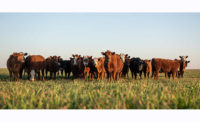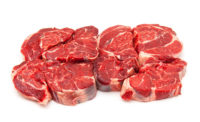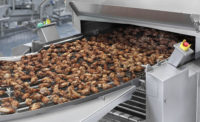The impact of storage temperature on water holding has been studied for several decades, and previous research has indicated that storage temperature can impact beef color stability and water capacity ultimately impacting product yield and consumer appeal (Hertog-Meischke et al., 1998; Jeremiah and Gibson, 2001). An estimated 2.55% of beef in retail stores is discarded due to discoloration resulting in approximately $3.73 billion in lost revenue for the beef industry annually (Ramanathan et al., 2022). Thus, it is imperative that cold storage of meat products is optimized for meat quality. However, one area of cold storage that is relatively unstudied is during the transport of products from source plants to distribution centers. Therefore, the objectives of this study were to (1) determine the influence of transportation temperature on purge loss of subprimal striploins and subprimal center-cut top sirloin butts; and (2) determine the influence of transportation temperature on moisture loss, color stability, and tenderness of fabricated striploin steaks and top sirloin steaks.
This study utilized commodity choice beef strip loins and top sirloin butts obtained directly from a source plant in Northeast Nebraska. Twenty-four cases of each subprimal were divided evenly between two refrigerated trucks set to hold at 28°F or 38°F. The trucks then transported the product 600 miles over the course of 12 hours prior to storing the palletized meat in a cooler set to hold at 34°F to mimic product transport to a case-ready facility. After nine days, the product was subset with one subprimal from the center of each box used for subprimal purge loss evaluation and to be fabricated into eight one-inch thick steaks. The steaks were divided into treatments of 28°F or 38°F truck temperature for a second transport, aging duration of 0 or 5 days of a shelf life evaluation conducted after the second transport, and refrigerated or frozen storage conditions. The steaks were then allocated onto refrigerated trucks for the second transport at the two temperatures. The second transport covered 640 miles over a 12 hour period. The steaks were then returned to the previously described holding cooler for another ten days to mimic transport and storage at a distribution facility. Steaks were then handled according to their previously assigned treatments (day 0 of case life and refrigerated storage, day 0 of case life and frozen storage, day 5 of case life and refrigerated storage, and day 5 of case life and frozen storage). Day 0 refrigerated storage steaks were immediately evaluated for purge loss and cooked to evaluate Warner-Bratzler shear force (WBSF) and cook loss. Day 5 refrigerated storage steaks were placed in a simulated retail setting under fluorescent lighting and instrumental color was evaluated until day 5 before purge loss, cook loss, and WBSF evaluation. Day 0 and day 5 frozen storage steaks were frozen at the appropriate time for evaluation of WBSF and cook loss at a later date.
Overall, the temperature of the first transport of subprimals impacted the measured quality attributes more than the temperature of the second transport of steaks. Strip loin subprimal purge loss was not impacted by first transport temperature. However, sirloin purge loss was increased for subprimals transported at 38°F. Fresh strip steaks transported at 28°F for the first transport had brighter, more yellow color scores and less purge loss than steaks transported at 38°F. Fresh sirloin steaks transported at 28°F for the first transport were darker and had less purge loss than the 38°F treatment. An aging day by first transport temperature interaction was observed for sirloin steak redness values where steaks that underwent first transport at 28°F remained redder from day 0 to 4 of case life evaluation. No impact of first transport temperature was observed for fresh strip steak redness values, fresh sirloin steak yellowness values, cook loss or shear force values, or frozen strip steak and sirloin steak purge loss, cook loss, or shear force values. Additionally, no differences were observed for the effect of second transport temperature on fresh strip steak color or shear force, fresh sirloin L* and b* values, purge loss, cook loss, and shear force, frozen strip steak purge loss and shear force, and frozen sirloin steak purge loss or cook loss.
In conclusion, the temperature at which meat products are transported is an important factor in product yield and color. However, these data indicate that the impact of transportation temperature is variable across subprimals. Therefore, a universal recommendation for all meat cuts cannot be made at this time and further investigation of the impacts of transportation temperature is critical for the optimization of the meat supply chain.
References
Hertog-Meischke, M. J. A., F. J. M. Smulders, and J. G. van Logtestijn. 1998. The effect of storage temperature on drip loss from fresh beef. J. Sci. Food Agr. 78:522–526. doi: https://doi.org/10.1002/(SICI)1097-0010(199812)78:4%3C522::AID-JSFA150%3E3.0.CO;2-F
Jeremiah, L. E., and L. L. Gibson. 2001. The influence of storage temperature and storage time on color stability, retail properties and case-life of retail-ready beef. Food Res. Int. 34:815–826. doi: https://doi.org/10.1016/S0963-9969(01)00104-1
Ramanathan, R., L. H. Lambert, M. N. Nair, B. Morgan, R. Feuz, G. Mafi, and M. Pfeiffer. 2022. Economic loss, amount of beef discarded, natural resources wastage, and environmental impact due to beef discoloration. Meat Muscle Biol. 6:13218, 1–8. doi: https://doi.org/10.22175/mmb.13218




Report Abusive Comment